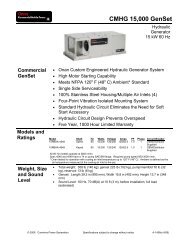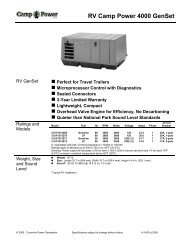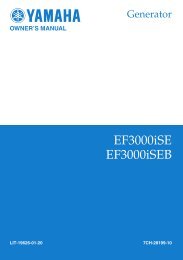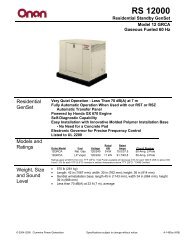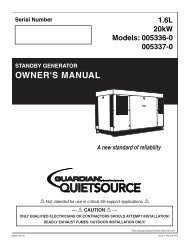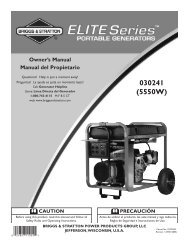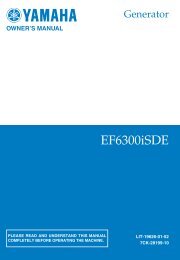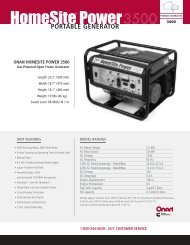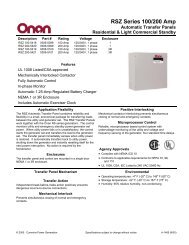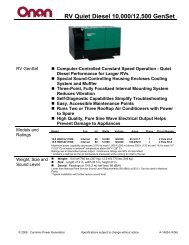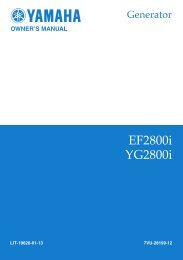Primepact 50 & 50LP RV Owner's Manual D7431 - Electric Generators
Primepact 50 & 50LP RV Owner's Manual D7431 - Electric Generators
Primepact 50 & 50LP RV Owner's Manual D7431 - Electric Generators
Create successful ePaper yourself
Turn your PDF publications into a flip-book with our unique Google optimized e-Paper software.
Section 2 – InstallationPRIMEPACT <strong>50</strong> Recreational Vehicle Generator• If flexible metal conduit is used, it must be sealedinternally at the end where it terminates inside thecompartment’s electrical junction box.NOTE:Flexible metal conduit, due to its unique construction,is NOT vapor tight along its entirelength.• Seams and joints of the galvanized steel (whetherused as a liner or for the compartment itself) mustbe lapped and mechanically secured. Such seamsmay be manufactured, welded, bolted, riveted orscrewed. Manufactured lock seams are shown inFigure 2.6. Installer constructed compartmentstypically utilize a standard lap joint.Figure 2.6 – Types of Lock Seams• After the compartment has been metal lined andvapor sealed, line the compartment interior wallsand ceiling with an approved, nonflammablesound insulating material. See Section 2.2.3.DANGERDo not install any flammable material directlyabove or around the compartment. Heat,transferred through the compartment structure,may be sufficient to ignite, char or discolorseat cushions, fiberboard and other flammablematerials. You may need to use approvednonflammable insulating materials in hightemperature areas.◆ 2.2.3 SOUND INSULATING MATERIALSOnce installers have determined that a compartmentis properly constructed and metal lined, they can addacoustical material. This may include additionalsealant or insulating material, to reflect noise awayfrom the vehicle interior.Sound insulating materials should be of a nonflammabletype. One excellent insulating material is a 1-inch (25 mm) thick fiberglass having a 2-pound density.When fiberglass is used, its coated side shouldface toward the compartment interior.24 Generac ® Power Systems, Inc.DANGERDo not install sound insulation or anyabsorbent material on the compartment floorinterior. Such materials will become soakedwith combustible or explosive vapors andliquids and will become a fire hazard.Using a combination of sound insulating materialscan often reduce noise more effectively than a singlematerial. For example, a sheet of lead or visco-elasticmaterial, along with a layer of other acoustical material,is more effective than when a single material isused.◆ 2.2.4 ACOUSTICSFor additional noise abatement, the installer maywish to consider the following:• Using special sound insulating materials.• Construction of a special noise abatementcompartment.NOTE:Any method used to reduce noise must notadversely affect the flow of cooling and ventilatingair into or out of the compartment.In addition to the effective use of sound insulatingmaterials, construction of a special noise abatementcompartment might be considered to reduce noiselevels. Such a compartment might be constructed asfollows (Figure 2.7):• Use 5/8-inch thick or 3/4-inch thick plywood in thecompartment.• Construct the compartment floor of a double thicknessof 5/8-inch or 3/4-inch plywood.• Line the compartment interior walls and floor, aswell as the underside of the floor, with 26-gaugegalvanized steel.• Vapor seal all compartment seams and joints.• Over the galvanized steel lining, install a combinationof acoustical materials as mentioned inSection 2.2.3.DANGERTo prevent fire or explosion, do not install anyinsulation or other absorbent materials on theinterior or underside of the compartment floor.• Seal all compartment door edges to prevent noiseleakage around the door perimeter.• Line the compartment door interior (except for airopenings) with suitable, fireproof sound insulation(such as 1-inch (25 mm) thick fiberglass with a 2-pound density).



